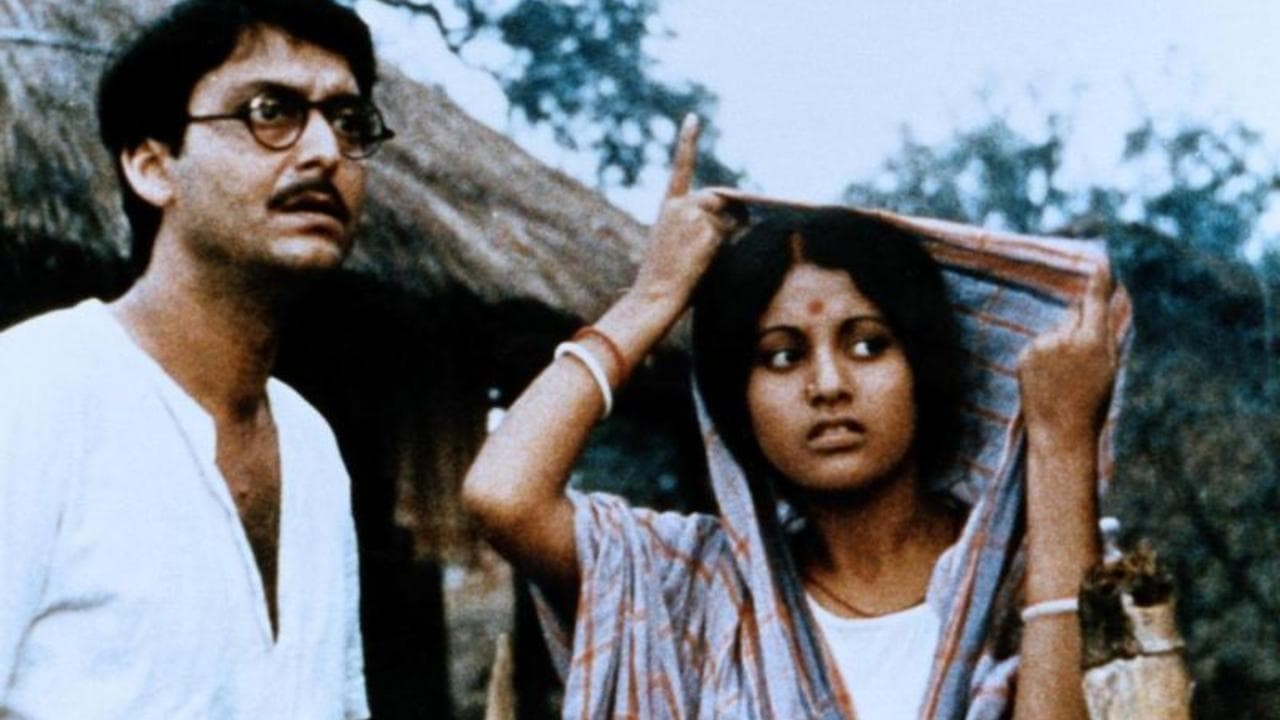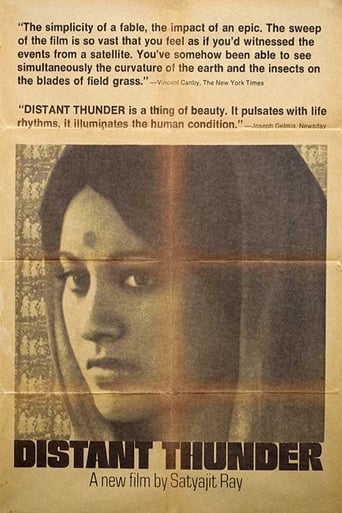LastingAware
The greatest movie ever!
Softwing
Most undeservingly overhyped movie of all time??
LouHomey
From my favorite movies..
TeenzTen
An action-packed slog
Chrysanthepop
The legendary Ray tackles what is known as The Great Bengal Famine in 1943 when India was still under the British Raj. Food was becoming scarcer as the price skyrocketed far beyond what was affordable and in the end, there just wasn't any left. With the attempt to help England during WWI, Churchill used the help of India and exported the majority of food that was so badly needed by the local Indians. As someone had stated, he also forbade other countries from offering any aid to India. The starvation resulted in more than 5,000 000 deaths.'Ashani Sanket' takes place in a poor rural Bengali village where most people are illiterate and even unaware of the war going on in the other side of the world. In a beautiful scene Ananga and her friend Chutki are fascinated by the flying jets which hardly means anything more to them than a distant thunder. They aren't even aware that those jets are flying to war. Gangacharan and Ananga are the newer inhabitants of the village and are of a 'sophisticated' Brahmin class. The villagers look up to them.However, as hunger strikes an become more severe, it gradually strips the villagers off their humanity (the fight over the rice) and integrity (Chutki offering herself in exchange of rice) but at the same time it also brings a more positive change in Gangacharan and Ananga. Gangacharan, who was arrogant and pompous, learns that he had lived his affluent life at the cost of the villagers. He becomes aware of the sacrifices others have made for him and that in this tragic ordeal there are no inequalities. Class does not matter for everyone is suffering equally. Consequently, he offers to give the the 'untouchable girl' a proper death ritual. The always compassionate Ananga grows from the naive housewife to a stronger woman.Ray's treatment is simple and this makes the portrayed village life look very authentic. At the same time he brings depth and there is plenty of detail and metaphor like the two butterflies that intrigue Ananga. Ray has always been known to be one of the greatest storytellers and 'Ashani Sanket' is no different. He gradually unfolds the story as he reveals how powerless hunger can cause humans to become and yet how these people fight to survive. On the technical front, background music is effectively minimalized and the cinematography is stupendous.Soumitra Chatterjee is marvelous. Obviously, there's a reason why Ray has repeatedly cast him in so many of his films. Thanks to Ray for discovering Babita's talent because this is one of the very very few movies in which she is given a role that does full justice to her acting abilities. Sandhya Roy too delivers a noteworthy performance as Chutki.'Ashani Sanket' is an astounding film that I found to be very enlightening. Many have claimed for it not to be their favourite Ray film but to me it's a remarkable film, another gem from the legend.
Gerald A. DeLuca
The subject matter of this small masterpiece is the famine which killed millions of people in Bengal during the war years after 1942 when Japan controlled Burma and a source of rice for India was then cut off. The "distant thunder" is the sound of an alien war, seemingly irrelevant, which nevertheless spreads its havoc. The central character is a Brahmin priest-teacher-doctor (Soumitra Chatterji) who with his wife (Babita)is forced to choose between survival for themselves or compassion for others less well-off than they are when confronted by scarcity, hoarding, and profiteering. Out of this background of horror and deprivation, the gifted director of the APU TRILOGY has fashioned a compassionate and understated picture leading inexorably to a haunting concluding image which must surely etch itself permanently into the memories and consciences of every viewer. This is a truly magnificent film.
maharani_md
The chemistry between Chatterjee and Babita is amazing in this classic study of the conflicts between religion, station, and the inner workings of human souls. Ray's best-known masterpiece improves with repeated viewings. Every time, I watch it, I pick up new nuances, particular on Babita's performance. The thin lines between devout and callous, love and loathing, & heroism and insanity have never been examined more in-depth or with greater insights. On one level, great art, on another flawlessly technical, but overwhelmingly emotionally draining in the best possible way.
Himadri
This film takes as its subject the Bengal famine of 1943 when, due to the negligence and indifference of the authorities, some 5 million lives were lost. The subject is certainly harrowing, but one does not come to a film like this for light entertainment.Ray focuses on a remote village, where the war is little understood, and is merely "distant thunder". The warplanes flying overhead are regarded uncomprehendingly, but with wonder. Soon, shortages of food start making themselves felt; the price of food rises above what may be afforded, and there is starvation.At the centre of this is a young Brahmin couple, who make use of their caste to earn a living. The horrific turn of events bring home to them the concept of social responsibility. When an untouchable girl dies at their door, they break the greatest caste taboo of all by deciding to dispose of the corpse themselves. In the context, this action is heroic; but this is heroism on the brink of extinction. The final unforgettable shot, where the sheer scale of the holocaust is brought home to us, sends a shiver down the spine even on repeated viewings.In dealing with this very difficult subject, Ray displays his usual all-embracing humanism, and a level of artisty that appears well beyond that of ordinary directors. This is not an easy film to watch, but is required viewing for anyone who values cinematic artistry, and by those who believe that horrors such as those depicted here should not be forgotten.

